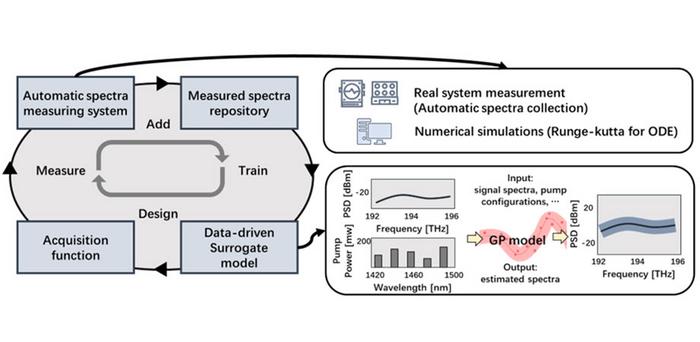Optical power evolution in fiber-optic networks: New framework for better modeling and control
With the emergence of internet services such as AI-generated content and virtual reality, the demand for global capacity has surged, significantly intensifying pressures on fiber-optic communication systems. To address this surge and reduce operational costs, efforts are underway to develop autonomous driving optical networks (ADONs) with highly-efficient network operations. One of the most important tasks […]

With the emergence of internet services such as AI-generated content and virtual reality, the demand for global capacity has surged, significantly intensifying pressures on fiber-optic communication systems. To address this surge and reduce operational costs, efforts are underway to develop autonomous driving optical networks (ADONs) with highly-efficient network operations. One of the most important tasks for an ADON is to accurately model and control the optical power evolution (OPE) over fiber links, since it determines the level of impairment noise and signal transmission quality. In fiber-optic communication systems, the optical power of signals evolves over the fiber and varies across different wavelengths, presenting a complex physical process, especially for multiband systems with severe Kerr nonlinearity and interchannel stimulated Raman scattering.

Credit: Liu et al., doi 10.1117/1.AP.6.2.026006.
With the emergence of internet services such as AI-generated content and virtual reality, the demand for global capacity has surged, significantly intensifying pressures on fiber-optic communication systems. To address this surge and reduce operational costs, efforts are underway to develop autonomous driving optical networks (ADONs) with highly-efficient network operations. One of the most important tasks for an ADON is to accurately model and control the optical power evolution (OPE) over fiber links, since it determines the level of impairment noise and signal transmission quality. In fiber-optic communication systems, the optical power of signals evolves over the fiber and varies across different wavelengths, presenting a complex physical process, especially for multiband systems with severe Kerr nonlinearity and interchannel stimulated Raman scattering.
In multiband ADONs, OPE is mainly influenced by fiber propagation and amplification processes. In particular, the primary challenge in modeling and controlling OPE lies in optical amplifiers (OAs). Data-driven approaches are able to achieve high accuracy. However, traditional data-driven methods, especially neural networks (NNs), demand extensive data to construct accurate digital twin models, leading to significant measurement costs. While some approaches can minimize required measurements through techniques like transfer learning or integrating physical knowledge, the perspective of data selection has received scant attention.
Recently, researchers from Shanghai Jiao Tong University (SJTU), Shanghai, China, proposed a Bayesian inference framework (BIF) to efficiently model and control the optical power evolutions in fiber-optic communication systems. Their research is reported in Advanced Photonics. Leveraging Bayesian theory, the BIF selects the next to-be-measured spectrum/OA configuration by both the performance estimation and uncertainty analysis. This approach enables simultaneous exploitation and exploration of a data space to identify the most suitable candidates, thus reducing the requisite data size.
The researchers conducted extensive experiments and simulations in C+L-band fiber-optic transmission systems, to model and control the OPE with heterogenous OAs, including an erbium-doped fiber amplifier (EDFA) and a Raman amplifier (RA). Compared with the NN-based modeling methods using randomly collected data, the proposed BIF can reduce the data needed for modeling by over 80 percent with an EDFA, and by over 60 percent with an RA. In terms of control, iterative adjustments of signal spectra and pump configurations were conducted, achieving arbitrary target gain/power spectra within fewer than 30 iterations.
This work provides an efficient approach to select data for measuring in a sequential manner. The measured data can be learned immediately to guide the next round of data collecting and optimization, thus achieving data-efficient modeling and controlling for OPE. Besides, the probabilistic analysis of the proposed framework shows a potential in reliability analysis for network operations, which is of vital importance for ADON.
According to corresponding author Prof. Qunbi Zhuge of SJTU, “The proposed framework can be a promising technical path for realizing data-driven ADON in future optical networks.”
For details, see the original Gold Open Access article by Liu et al., “Digital twin modeling and controlling of optical power evolution enabling autonomous-driving optical networks: a Bayesian approach,” Adv. Photon. 6(2) 026006 (2024), doi 10.1117/1.AP.6.2.026006.
Journal
Advanced Photonics
DOI
10.1117/1.AP.6.2.026006
Article Title
Digital twin modeling and controlling of optical power evolution enabling autonomous-driving optical networks: a Bayesian approach
Article Publication Date
26-Mar-2024
What's Your Reaction?

































